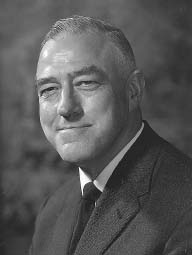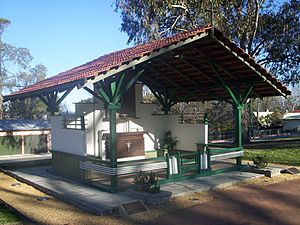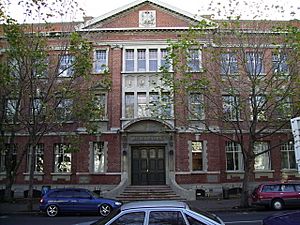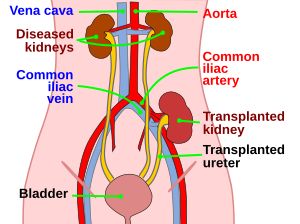Michael Woodruff facts for kids
Quick facts for kids
Sir
Michael Woodruff
FRS FRSE FRCS
|
|
|---|---|
 |
|
| Born | 3 April 1911 Mill Hill, London, England
|
| Died | 10 March 2001 (aged 89) Edinburgh, Scotland
|
| Alma mater | University of Melbourne |
| Awards |
|
| Scientific career | |
| Fields | Organ transplantation |
| Institutions | Universities of Sheffield, Aberdeen, Otago, Edinburgh |
Sir Michael Francis Addison Woodruff (3 April 1911 – 10 March 2001) was an English surgeon and scientist. He is best known for his important work on organ transplantation. This is when doctors move an organ from one body to another.
Michael Woodruff was born in London, England. But he grew up in Australia. There, he studied electrical engineering and medicine. When World War II started, he joined the Australian Army. He was captured by Japanese forces and became a POW in the Changi Prison Camp. While imprisoned, he found a clever way to get important nutrients from farm waste. This helped prevent his fellow prisoners from getting sick due to poor food.
After the war, Woodruff returned to England. He became a surgeon and a researcher. He studied why the body sometimes rejects a transplanted organ. He also looked into ways to stop this rejection. His research led him to perform the first kidney transplant in the United Kingdom. This happened on October 30, 1960. For his amazing work, he was made a Knight Bachelor in 1969. This means he was given the title "Sir" by the Queen. He stopped performing surgery in 1976. But he kept working in science, researching cancer and helping medical groups.
Contents
Early Life and Education
Michael Woodruff was born in Mill Hill, London, England, on April 3, 1911. His father, Harold Addison Woodruff, was a professor of veterinary medicine. In 1913, his family moved to Australia. His father became a professor at the University of Melbourne.
The family returned to London during World War I. Michael's mother passed away in 1917. Michael and his brother then went back to Australia to live with their father. Michael went to Trinity Grammar School and later Wesley College in Melbourne. He enjoyed math and rowing.
He earned a scholarship to the University of Melbourne. He first studied electrical engineering and mathematics. Even though he was very good at engineering, he worried about finding a job during the Great Depression. So, he decided to study medicine. He finished his engineering degree with top honors in 1933. Then, he started medical school.
In 1937, he finished his medical degree. He also won two awards for surgery. After graduating, he worked as a house surgeon at the Royal Melbourne Hospital. This is where he began his training to become a surgeon.
World War II Experience
When World War II began, Woodruff joined the Australian Army Medical Corps. He finished his Master of Surgery degree in 1941. Then, he was sent to British Malaya as a captain. The war in the Pacific soon became very intense. He was moved to a hospital in Singapore. When Singapore fell to the Japanese, Woodruff was captured.
Woodruff was held in the Changi Prison Camp. He noticed that many prisoners were getting sick because they lacked vitamins. He got permission from the Japanese to help. He found a way to get important nutrients from grass, soya beans, and farm waste. He used old machines he found in the camp. He later wrote a report about his methods. He was a POW for three and a half years. He also treated other prisoners in different camps. He had to be creative because supplies were limited. He read a surgery textbook in the camp. This book mentioned that skin allografts (skin from another person) were rejected after a few weeks. This made him very interested in studying organ rejection.
After the war, Woodruff went back to Melbourne to finish his surgical training. He met Hazel Ashby, a science graduate, and they married in 1946. They worked together on research for the rest of their lives.
Starting His Career
Soon after getting married, Woodruff traveled to England. He wanted to take a special exam to become a Fellow of the Royal College of Surgeons of England. He got a job as a surgery tutor at the University of Sheffield. He passed his exam in 1947.
Sheffield and Aberdeen
At Sheffield, Woodruff trained in surgery. He also started studying transplant rejection. This is when a patient's immune system attacks transplanted tissue. He was very interested in why some transplants, like thyroid tissue placed in the eye, were not rejected. This work helped him get a strong start in the new field of transplantation. He also met Peter Medawar, a famous scientist who studied rejection. They became long-time colleagues.
In 1948, Woodruff moved to the University of Aberdeen in Scotland. He had better lab access there. He also received a grant so his wife could work as his lab assistant. They studied in utero grafts. This meant trying to transplant tissue into babies while they were still in the womb. The idea was that this might help them accept transplants later in life. His experiments with rats did not show success. He also started working on a medicine called antilymphocyte serum to stop the body from rejecting organs.
Woodruff also visited the United States. He met many top American surgeons. This made him even more determined to continue his research. He studied how different blood types affected rejection. He found that even with matching blood types, skin grafts could still be rejected. This showed that other factors were involved. In 1951, he gave an important lecture on transplanting tissue.
Dunedin
In 1953, Woodruff became a Professor of Surgery at the University of Otago in Dunedin, New Zealand. He researched how white blood cells might help the body accept transplants. This research did not work out. But he did achieve other important things. He created a frozen skin bank to help treat burn victims. He also studied a condition called runt disease. After four years, he decided to look for a new job because Dunedin was too small to support a large medical school.
Work in Edinburgh
In 1957, Woodruff was appointed to a special surgical science position at the University of Edinburgh. He spent half his time teaching and performing surgery. The other half was for research. He also led a research group focused on transplantation.
His research group studied how the body learns to accept new tissues. They also looked at how the body's immune system reacts to cancer. In his clinical work, Woodruff started a vascular surgery program. He also used special treatments to help people with cancer and certain blood diseases. But his most important work was with kidney transplantation.
Woodruff performed the first kidney transplant in the UK. This happened at the Royal Infirmary of Edinburgh. He had been waiting for the right patient. He hoped to find a patient with an identical twin who could be the donor. This would greatly lower the chance of the body rejecting the new kidney. On October 30, 1960, he found such a patient. A 49-year-old man received a kidney from his twin brother. Both twins lived for another six years. Woodruff believed he had to be very careful with this first transplant. He felt that many British doctors were cautious about transplantation. From then until he retired in 1976, he performed 127 kidney transplants.
In 1960, Woodruff also published a book called The Transplantation of Tissues and Organs. This book was a full guide to transplant biology. He wrote seven books in total. In 1969, he received the Lister Medal for his contributions to surgery.
His successful transplant program received funding to build a new unit. In 1970, a serious health issue affected the transplant unit. The unit had to close for a while. An investigation was done to make sure such problems could be avoided in the future. The unit then reopened.
Woodruff retired from the University of Edinburgh in 1976. He then joined a research unit that studied cancer. He spent ten years there, focusing on how the immune system fights tumors. During this time, he published many papers and two more books. After retiring from cancer research, Woodruff lived quietly in Edinburgh with his wife until he passed away on March 10, 2001.
His Legacy
Woodruff's work in surgery was very important and long-lasting. He performed the first kidney transplant in the UK. He also developed a way to connect a transplanted ureter (a tube from the kidney) to the bladder. This method is still used today. He built a large and effective transplant unit in Edinburgh. It is still one of the best in the world.
He is most famous for his clinical work. But his research on rejection and acceptance of organs was just as important. For example, his work with anti-lymphocyte serum is still used widely. It helps reduce rejection symptoms in people who receive organ transplants.
His contributions to medicine were honored in 1968. He was chosen to be a Fellow of the Royal Society. The next year, in 1969, the Queen made him a Knight Bachelor. This is a rare honor for a surgeon. Many medical groups gave him honorary memberships. These included the American College of Surgeons. Woodruff also held important positions in scientific groups. He was Vice-President of the Royal Society. He was also President of The Transplantation Society. He served as an advisor for the WHO for many years. He was also a visiting professor at several universities.
Even though he had a huge impact on transplantation, Woodruff was not known for being a great speaker. He sometimes mumbled. But he was known for his clever way with words and a good sense of humor. His influence on transplantation at all levels was enormous.
Books He Wrote
Woodruff wrote many books and papers. This shows how much he contributed to medicine and surgery. He wrote eight books during his career:
- Deficiency Diseases in Japanese Prison Camps. (1951)
- Surgery for Dental Students. (1954)
- The Transplantation of Tissues and Organs. (1960)
- The One and the Many: Edwin Stevens Lectures for the Laity. (1970)
- On Science and Surgery. (1976)
- The Interaction of Cancer and Host: Its Therapeutic Significance. (1980)
- Cellular Variation and Adaptation in Cancer: Biological Basis and Therapeutic Consequences. (1990)
- Nothing Venture Nothing Win. (His autobiography) (1996)
Personal Life
In 1946, Woodruff married Hazel Gwenyth Ashby. They had two sons and a daughter. Their first son became a civil engineer. Their daughter studied botany. Their second son became an ophthalmologist (an eye doctor).
The Woodruffs loved playing tennis. They even had a tennis court at their home in Edinburgh. After moving to Edinburgh, Woodruff started sailing. He owned a boat and would sail in the Mediterranean each summer with his wife. When he was a student, he enjoyed rowing and playing field hockey.
Woodruff loved classical music. He learned to play the organ and piano. In his free time, he also enjoyed pure mathematics, especially number theory. He tried to prove Fermat's Last Theorem many times, but he did not succeed.
Images for kids
See also
 In Spanish: Michael Woodruff para niños
In Spanish: Michael Woodruff para niños





